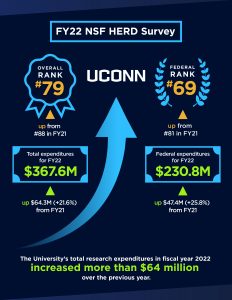UConn’s rankings have leapt in the National Science Foundation (NSF) survey that measures colleges and universities according to their expenditures in research and development.
NSF’s Center for Science and Engineering Statistics surveyed more than 900 schools across the country that spent more than $150,000 in research expenditures during the 2022 fiscal year. The data are compiled into the annual Higher Education Research and Development (HERD) Survey.
In the most recent survey, UConn jumped to 79th in overall expenditures, moving up nine spots from 88th in the 2021 fiscal year. The University’s total research expenditures in fiscal year 2022 increased more than $64 million over the previous year, hitting a record $367.6 million invested in research and development.
“The increase in funding and advance in the rankings reflect our progress in prioritizing research at UConn,” says Pamir Alpay, UConn’s vice president for research, innovation, and entrepreneurship. “Across our schools and colleges, our success in securing federal and state grants is a testament to the strength of our faculty. Combined with the University’s investment, we are seeing UConn gain in competitiveness compared to other premier research institutions across the country.”
Psychology expenditures at UConn are exceptionally strong, ranking 7th in the nation among all institutions, public and private.

UConn’s significant rise in federal expenditures, the result of awards from the National Institutes of Health (NIH), NSF, and other federal agencies, helped drive strong rankings overall. UConn’s nearly $231 million ranked 69th in the U.S., a leap of 12 places over the previous HERD data.
Setting UConn records, expenditures rose almost $34 million at Storrs, an 18% increase, and UConn Health saw a hefty increase in expenditures, up $31.4 million and 28%.
The rankings place UConn ahead of most regional R1 public universities, or institutions that conduct very high levels of research. Among New England institutions both public and private, only Harvard, Yale, MIT, and Boston University ranked higher than UConn.
Among all institutions, Johns Hopkins University was far and away the top ranked institution in the HERD survey, with more than $3.4 billion in expenditures. Its closest competitor—the University of California-San Francisco—expended $1.8 billion. The top 30 in the rankings all had $1 billion or more expenditures for research and development in FY22.
Inside UConn’s Expenditures
Expenditures are the funds that universities spend to conduct research. UConn’s research funding comes from two main sources: federal grants and institutional funds. Federal grants—such as awards from the NSF, NIH, Department of Energy, the USDA, and many more agencies—account for the majority of funding. Institutional expenditures are funds that universities invest in their own research programs and faculty. These investments are critical to building the capabilities faculty need to compete for externally funded research. Awards from other sources, such as companies, philanthropic organizations, and state or municipal governments, also support research.
The $230.8 million in federal expenditures reflects a gain of $47.4 million over the previous year. UConn has been on an upward trajectory for federal expenditures, with researchers earning more in awards to fund their projects. UConn’s federal expenditures totaled $129.9 million at Storrs and regional campuses and $100.8 million at UConn Health, both record numbers for the University.
Institutional expenditures also continue to rise. In FY22, UConn expended $105.6 million in institutional funding, up more than $17 million over the previous year.



